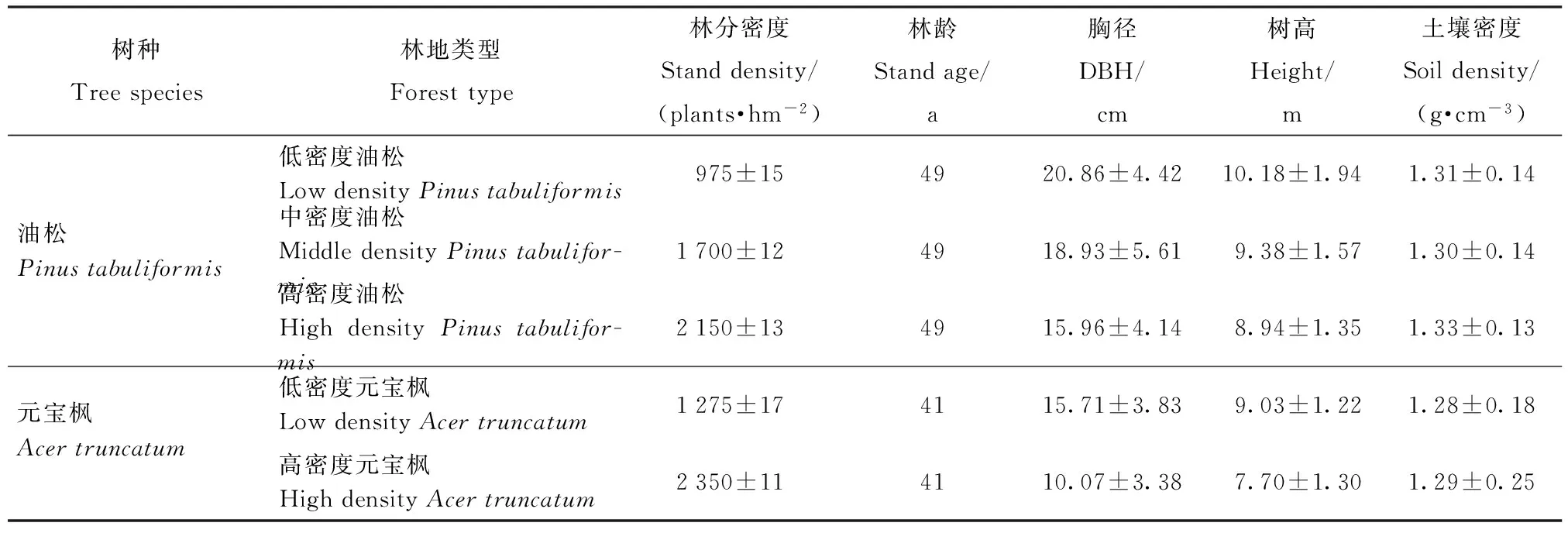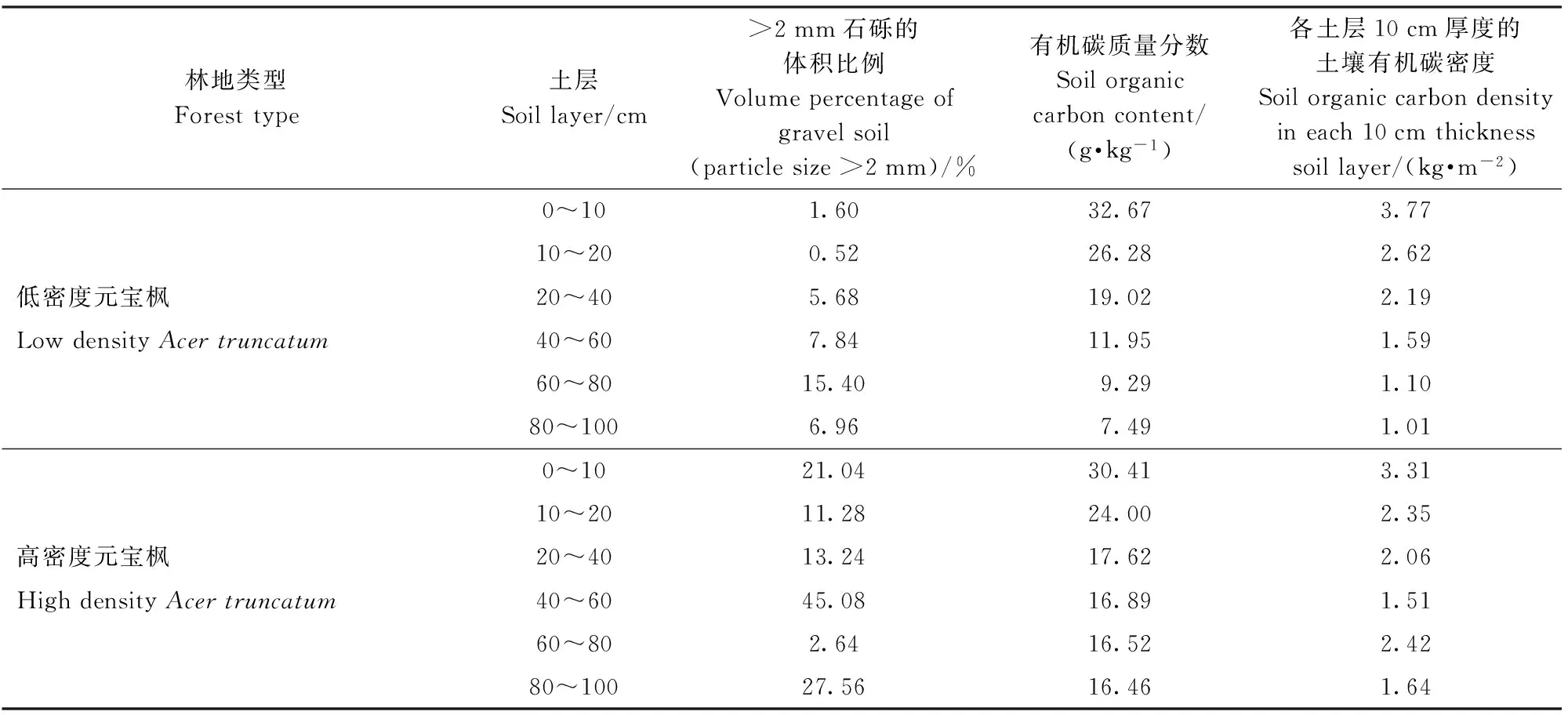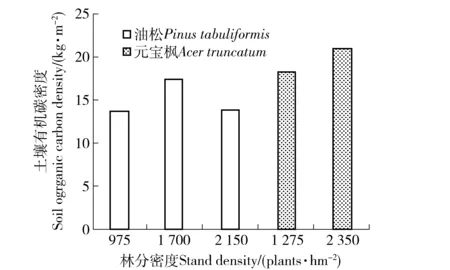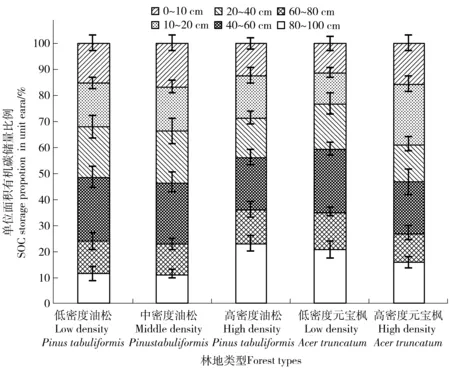华北土石山区油松和元宝枫人工林土壤有机碳特征
2016-06-18朱丽平蔡永茂康满春赵广亮陈左司南张志强
朱丽平, 蔡永茂, 康满春, 赵广亮, 陈左司南, 张志强†
(1.北京林业大学 水土保持学院 水土保持与荒漠化防治教育部重点实验室,100083,北京;2.北京市八达岭林场,102112,北京)
华北土石山区油松和元宝枫人工林土壤有机碳特征
朱丽平1, 蔡永茂2, 康满春1, 赵广亮2, 陈左司南1, 张志强1†
(1.北京林业大学 水土保持学院 水土保持与荒漠化防治教育部重点实验室,100083,北京;2.北京市八达岭林场,102112,北京)
摘要:森林生态系统土壤有机碳的储量及时空变化是制定森林生态系统可持续经营管理措施的重要依据,对全球碳循环与碳平衡的研究具有十分重要的理论价值。以华北土石山区不同密度油松和元宝枫人工林为研究对象,对不同林地类型的土壤密度、pH值以及全氮、速效钾、有机碳的质量分数等参数进行测定,对比分析不同林地类型土壤有机碳的质量分数、土壤有机碳密度、储量及垂直分布特征,探讨土壤有机碳质量分数与土壤理化性状的相关关系。结果表明:元宝枫林的平均土壤有机碳质量分数和有机碳密度均大于油松林的;土壤有机碳质量分数和有机碳密度在土壤表层(0~10 cm)为最高值并随土壤深度的增加而降低;土壤有机碳质量分数表现为2种林分密度下的元宝枫林无显著差异,而有机碳密度则表现为高密度元宝枫林>低密度元宝枫林;在油松林中土壤有机碳质量分数、有机碳密度均表现为中密度油松林>高密度油松林和低密度油松林。油松林和元宝枫林土壤有机碳质量分数与土壤密度均呈显著负相关,而全氮、速效钾与其呈显著正相关,油松林土壤有机碳质量分数与pH值呈显著相关,而元宝枫林土壤有机碳质量分数与pH值不相关。综上所述,华北土石山区元宝枫林较油松林具有更大的固碳潜力,而且土壤的有机碳质量分数及有机碳密度受树种和林分密度影响较大。
关键词:土壤有机碳; 碳密度; 油松林; 元宝枫林; 华北土石山区
土壤碳库包括土壤有机碳(soil organic carbon, SOC)库和无机碳库2部分。相比于土壤无机碳库[1-2],土壤有机碳库库容更大,大约是陆地植被碳库的1.5~3.0倍[3-4],是全球大气碳库的2倍多[5],且因土壤有机碳不稳定,使得其对大气CO2年通量的贡献远大于化石燃料[6],是CO2等温室气体的重要来源;因此对其的研究对全球碳循环有着重要的意义[3-6]。近年来,国内不少学者对我国土壤有机碳做了大量研究,其中李克让等[7]、周玉荣等[8]、解宪丽等[9]依据土壤普查资料分别对中国不同植被类型下土壤有机碳进行系统的研究;但由于植被分类较粗糙,这些研究很难精确到某一树种类型和具体的林分经营措施,因此,研究不同林地类型以及同一林地类型不同林分密度的土壤有机碳是十分必要的[10]。土壤有机碳显著影响着土壤物理、化学以及生物学特性[11];因此通过对不同植被人工林生态系统中土壤理化性质的研究,可以分析土壤有机碳质量分数与土壤理化性质的关系对植被类型的响应,进而为一定区域内具体的人工林经营管理提供科学依据。
油松(Pinustabuliformis)和元宝枫(Acertruncatum)因耐干旱瘠薄,是华北土石山区主要的造林树种,在改良土壤、保持水土方面具有重要的作用。目前针对华北土石山区具体树种和林分经营模式下有机碳特征的分析报道较少,特别是不同林分经营模式下土壤有机碳质量分数、碳密度及碳储量的分布特征的研究较少,不能为基于保护人工林土壤碳储量和碳汇功能的经营改造及植被恢复模式提供理论依据和技术支撑。鉴于此,本研究以不同密度的油松和元宝枫人工纯林为研究对象,采用野外调查和室内分析相结合的方法,测定分析不同密度林地类型下不同土壤层有机碳质量分数及有机碳密度,探讨土壤有机碳质量分数与主要土壤理化指标的相关关系,阐明人工林土壤碳汇功能对林地类型和密度经营水平的响应规律,其目的在于为全面认识华北土石山区森林生态系统土壤有机碳特征,准确评估该区森林生态系统土壤碳储量和人工林的经营管理提供依据。
1研究区概况
研究区位于北京西北部延庆县境内的北京市八达岭林场(E 116°01′,N 40°20′),平均海拔780 m,坡度多在30°~35°之间,多为阴坡或半阴坡。气候类型为大陆性季风气候,年平均气温10.8 ℃,无霜期约为160 d,年均降水量454 mm。土壤类型属于山地褐土,土壤层较薄,腐殖质层厚约3 cm。林场总面积2 940 hm2,其中针叶林1 478 hm2、阔叶林360 hm2、针阔混交林52.2 hm2、灌木林地1 003.5 hm2。
2材料与方法
2.1样品采集与分析
2014年4月,依据典型性和代表性的原则,在试验区选取立地条件一致的49年生3种密度类型的油松人工林,同时选取41年生2种密度类型的元宝枫人工林。在以上不同密度类型的油松林和元宝枫林中分别各选取3个20 m×20 m的标准样地进行指标调查和测定,不同林地类型基本情况见表1。每个标准样地内按照“S”型设置3个1 m×1 m样方采集土壤样品,根据土壤层次性特点及土壤有机碳储量的计算方法,按0~10、10~20、20~40、40~60、60~80 和80~100 cm分6层取样,共取样270个用于测定土壤有机碳储量,同时用环刀(100 cm3)采集土样270个用于测定土壤密度。
土壤样品于室内风干,除去其中的草根等杂质,过2 mm筛,测定粒径>2 mm的石砾所占的体积分数;采用德国Elementar TOC(Germany)元素分析仪测定土壤有机碳质量分数,采用电位法测定pH值,用土壤养分测定仪测定全氮和速效钾;环刀样品在105 ℃烘干至恒重,测定土壤密度。

表1 不同林地类型基本情况
注:表中数值为均值±标准误。Note: The values are mean value±standard error.
2.2数据处理
某一土层的有机碳密度[12-14]
Si=(1-θi)piCiTi/100。
(1)
式中:Si为第i层土壤有机碳密度,kg/m2;Ci为第i层土壤有机碳质量分数,g/kg;pi为第i层土壤平均密度,g/cm3;θi为第i层>2 mm土壤石砾的体积百分数;Ti为第i层土壤厚度,cm;本研究以1 m深为标准。
如果某一土壤剖面有n层组成,该剖面的有机碳密度[13]

(2)
式中S为某一土壤剖面的有机碳密度,kg/m2。
由于土壤有机碳密度是指单位面积一定深度的土层中土壤的有机碳储量,因此某一土层单位面积有机碳储量即该土层的有机碳密度,其占整个土壤剖面总有机碳储量的比例[12]

(3)
式中Ri为某一土层单位面积有机碳储量占整个土壤剖面总有机碳储量的比例,%。
另外,为便于比较,不同林地类型下0~100 cm深度范围内的土壤有机碳质量分数采用该深度范围内各层土壤有机碳质量分数的加权平均值表示;不同厚度土层的土壤有机碳密度统一用10 cm土壤厚度的土壤有机碳密度表示。
采用Excel 2007处理数据,SPSS 18软件进行显著性分析和相关性分析。
3结果与分析
3.1土壤有机碳质量分数
不同林地类型土壤有机碳质量分数(图1)总体表现为元宝枫林(17.19±2.47)g/kg>油松林(12.77±2.11)g/kg(P<0.05)。在土壤垂直剖面上不同土层土壤有机碳质量分数(表2)表现为,表层(0~10 cm)最大,且随土壤深度的增加均呈降低趋势。油松林地中,0~100 cm土壤深度内中密度油松林的平均土壤有机碳质量分数显著高于低密度和高密度油松林(P<0.01),但高密度油松林在0~10 cm土层的土壤有机碳质量分数分别是中密度油松林、低密度油松林的1.56、1.88倍;而在10~100 cm深度范围内,土壤有机碳质量分数则表现为中密度油松林(14.73±1.25)g/kg>低密度油松林(10.50±2.62)g/kg>高密度油松林(8.90±3.19)g/kg(P<0.01)。
在1 m深度内,元宝枫林平均土壤有机碳质量分数在高、低密度林分间的差异不显著(P=0.87)。在0~40 cm深度范围内土壤有机碳质量分数低密度元宝枫林与高密度元宝枫林无显著差异(P>0.05);但在40~100 cm深度范围内土壤有机碳质
量分数高密度元宝枫林是低密度林(9.57±2.24)g/kg的1.74倍(P<0.05)。以上分析表明,林地土壤有机碳质量分数及其垂直分布受植被类型、林分密度的影响较大。

图1 土壤有机碳质量分数随土层变化Fig.1 Change of soil organic carbon (SOC) content with soil layer

林地类型Foresttype土层Soillayer/cm>2mm石砾的体积比例Volumepercentageofgravelsoil(particlesize>2mm)/%土壤有机碳质量分数Soilorganiccarboncontent/(g·kg-1)各土层10cm厚度的土壤有机碳密度Soilorganiccarbondensityineach10cmthicknesssoillayer/(kg·m-2)0~103.7615.121.5610~206.8814.531.69低密度油松20~402.7212.771.67LowdensityPinustabuliformis40~604.609.701.3260~802.209.061.1580~10013.888.451.050~1020.0418.241.9510~2015.0817.802.01中密度油松20~4013.2417.582.05MiddledensityPinustabuliformis40~602.8016.151.7260~8011.8414.121.4980~10028.1213.541.440~102.6828.413.1910~202.6414.041.77高密度油松20~402.6811.271.40HighdensityPinustabuliformis40~600.928.051.0360~800.447.451.1380~1002.086.240.86

表2(续)

图2 土壤有机碳质量分数与土壤理化性质的关系Fig.2 Relationship between soil organic carbon (SOC) and soil physical and chemical properties
3.2土壤有机碳质量分数与土壤理化性质的关系
油松、元宝枫林土壤有机碳质量分数与土壤密度呈显著负相关(图2(a)),P油松= 0.015、P元宝枫= 0.050,随土壤密度的增大,土壤有机碳质量分数逐渐降低。油松林土壤有机碳质量分数与pH值显著相关(图2(b)),P油松= 0.001;而元宝枫林土壤有机碳质量分数与pH值无显著相关关系,P元宝枫= 0.34。
土壤有机碳质量分数与全氮和速效钾的质量分数显著相关(图2(c)和图2(d)),随着全氮和速效钾质量分数分别在0~5.0 g/kg和0~250 mg/kg的范围内上升,油松林和元宝枫林土壤有机碳质量分数都呈现逐渐增大的趋势。
3.3土壤有机碳密度
结果(图3)表明:不同林地类型下0~100 cm土壤有机碳密度介于13.63~20.93 kg/m2之间且差异较大,其中元宝枫林高于油松林。0~100 cm土层高密度元宝枫林的土壤有机碳密度(20.93 kg/m2)是低密度元宝枫林土壤有机碳密度(18.18 kg/m2)的1.15倍(P<0.05);中密度油松林的土壤有机碳密度(17.35 kg/m2)显著高于高密度油松林(13.81 kg/m2)和低密度油松林(13.63 kg/m2)(P<0.01),中密度油松林土壤有机碳密度分别比高密度油松林、低密度油松林高25.63%、27.27%。

图3 不同密度油松、元宝枫林的土壤有机碳密度Fig.3 Soil organic carbon density of Pinus tabuliformis plantation and Acer truncatum plantation in different stand density

图5 不同林地类型土壤有机碳储量剖面分布Fig.5 Soil organic carbon storage of different forest types at different horizons
不同林地类型土壤各层10 cm厚度的土壤有机碳密度主要表现为随着土层深度的增加而降低(图4)。在0~100 cm深度范围内,不同林地类型下各土层土壤有机碳密度的变化范围有所不同(表2):其中低密度油松林为(1.41±0.25)kg/m2,中密度油松林为(1.78±0.24)kg/m2,高密度油松林为(1.56±0.78)kg/m2;元宝枫林中,低密度元宝枫林为(2.05±0.95)kg/m2,高密度元宝枫林为(2.22±0.59)kg/m2,整体上油松林的平均土壤有机碳密度要低于元宝枫林的(P<0.05)。

图4 不同林地类型土壤各土层10 cm厚度的平均有机碳密度Fig.4 Mean soil organic carbon density in each 10 cm soil layer of different forest types
不同土层单位面积土壤有机碳储量占总土壤有机碳储量的比例(图5)表现为随着土层深度的增加,不同林地中0~10, 10~20,20~40,40~60,60~80,80~100 cm各土层单位面积有机碳储量占总土壤有机碳储量的比例随着土层深度的增加整体表现出先增加后降低的趋势。在同一林地类型下,除低密度元宝枫林,相同厚度(20 cm)表层土壤(0~20 cm)的单位面积有机碳储量占总有机碳储量的比例要高于20~100 cm深度范围内任何土层所占的比例。
4讨论
4.1人工林树种对土壤有机碳分布的影响
土壤有机碳库的大小取决于植被枯落物分解输入和土壤呼吸输出[15]。植被类型不仅会影响枯落物的产量和质量[16],也会影响土壤微生物的微环境[17],是影响土壤有机碳库的重要因素。土壤表层覆盖大量的动植物腐殖质,同时植被根系也主要集中于土壤表层;因此在油松针叶林和元宝枫阔叶林中0~10 cm土层有机碳质量分数(20.59、31.54 g/kg)显著高于10~100 cm中其他各土层的质量分数。随着土壤深度的增加,植物根系和腐殖质减少,油松针叶林和元宝枫阔叶林土壤有机碳质量分数逐渐降低,这与目前大部分研究结果一致[18-21]。在本研究中,0~100 cm土壤深度范围不同林分密度下平均土壤有机碳密度油松林(14.93 kg/m2)低于元宝枫林(19.55 kg/m2)。在气候和土壤类型条件一致的情况下,根据相关研究,这可能与油松和元宝枫2个树种的枯落物产量及枯落物分解速率有关。张新平等[22]的研究表明阔叶林枯落物产量高于针叶林,而张德强等[17]在研究枯落物的分解速率时发现阔叶林枯落物的分解速率较针叶林大,土壤有机碳密度阔叶元宝枫林的大于针叶油松林。这说明在气候和土壤条件相同的情况下,阔叶元宝枫林有着比针叶油松林更高的土壤固碳能力,这与李克让等[7]和周玉荣等[8]的研究结果一致。
4.2油松和元宝枫人工林林分密度对土壤有机碳分布的影响
林分密度的改变会引起人工林地上植被碳库的改变,也会通过影响林下小气候和土壤理化特性,改变土壤呼吸和微生物活性,从而使土壤有机碳质量分数和有机碳密度发生变化。一般情况下,随着林分密度的减小,会引起枯落物输入的降低,从而造成土壤有机碳质量分数下降[10]。元宝枫林在2种林分密度条件下表现为高林分密度时的土壤有机碳密度大于低密度时的;但不同林分密度条件下的油松林土壤有机碳密度随林分密度的增加先增大再减小,其中油松、元宝枫林林分密度分别为1 700、2 350株/hm2时的土壤有机碳密度为最大。任丽娜等[10]建议:华北油松林林分合理密度应为1 104株/hm2;但若以油松林土壤固碳能力为人工林经营管理的目标,则可以适当增大油松林林分密度。
4.3土壤理化性质与土壤有机碳

5结论
土壤有机碳质量分数、碳密度及其垂直分布特征受植被类型、林分密度的影响较大,其中土壤有机碳质量分数在整体上表现为元宝枫林>油松林,而在不同的林分密度条件下,油松林表现为中密度油松林>高密度油松林>低密度油松林,而元宝枫林则并无高、低密度间的差异。表层(0~10 cm)土壤有机碳质量分数最高,随着土壤深度的增加,土壤有机碳质量分数逐渐降低。土壤理化性质和油松、元宝枫人工林土壤有机碳质量分数的关系表现为:油松、元宝枫林土壤有机碳质量分数与土壤密度呈显著负相关,而与全氮和速效钾呈显著正相关。油松林土壤有机碳质量分数与pH值显著相关,而元宝枫林则没有相关关系。不同林分密度间土壤有机碳密度表现为高密度元宝枫林>低密度元宝枫林的,中密度油松林显著>高密度和低密度油松林;但整体上,平均土壤有机碳密度表现为元宝枫林>油松林,表明在华北土石山区元宝枫林较油松林具有更大的固碳潜力。
6参考文献
[1]Schlesinger W H. Carbon storage in the caliche of arid soils a case study from Arizona [J]. Soil Science, 1982, 133(4):247.
[2]陈庆强, 沈承德, 易惟熙, 等. 土壤碳循环研究进展[J]. 地球科学进展, 1998, 13(6): 555.
Chen Qingqiang, Shen Chengde, Yi Weixi, et al. Progresses in soil carbon cycle researches [J]. Advance in Earth Sciences, 1998, 13(6):555. (in Chinese)
[3]Post W M,Peng T H, Emanuel W R, et al. The global carbon cycle [J]. American Scientist, 1990, 74(4):310.
[4]Houghton R A, Skole D L Carbon. The Earth as transformed by human action [M]. In Turner B L, Clark W C, Kates R W et al eds. Cambridge: Cambridge University Press, 1990: 393-408.
[5]苏永中, 赵哈林. 土壤有机碳储量、影响因素及其环境效应的研究进展[J]. 中国沙漠, 2002, 22(3): 220.
Su Yongzhong, Zhao Halin. Advances in researches on soil organic carbon storages, affecting factors and its environmental effects [J]. Journal of Desert Research, 2002, 22(3):220. (in Chinese)
[6]IPCC (Intergovernmental Panel on Climate Change). Scientific assessment of climate change. World meteorological organization/United nations environmental program [M]. New York: Cambridge University Press, 1990: 81.
[7]李克让, 王绍强, 曹明奎. 中国植被和土壤碳贮量[J]. 中国科学, 2003, 33(1): 72.
Li Kerang, Wang Shaoqiang, Cao Mingkui. Chinese vegetations and soil carbon storage [J]. Science in China, 2003, 33(1):72. (in Chinese)
[8]周玉荣, 于振良, 赵士洞. 我国主要森林生态系统碳贮量和碳平衡[J]. 植物生态学报, 2000, 24(5): 518.Zhou Yurong, Yu Zhenliang, Zhao Shidong. Carbon storage and budget of major Chinese forest types [J]. Acta Phytoecologica Sinica, 2000, 24(5):518. (in Chinese)
[9]解宪丽, 孙波, 周慧珍, 等. 不同植被下中国土壤有机碳的储量与影响因子[J]. 土壤学报, 2004, 41(5): 687.
Xie Xianli, Sun Bo, Zhou Huizhen, et al. Soil carbon stocks and their influencing factors under native vegetations in China [J]. Acta Pedologica Sinica, 2004, 41(5):687. (in Chinese)
[10] 任丽娜, 王海燕, 丁国栋, 等. 林分密度对华北土石山区油松人工林土壤有机碳及养分特征的影响[J]. 干旱区地理, 2012, 35(3): 456.
Ren Lina, Wang Haiyan, Ding Guodong, et al. Effects ofPinustabulaeformisCarr. plantation density on soil organic carbon and nutrients characteristics in rocky mountain area of Northern China [J]. Arid Land Geography, 2012, 35(3):456. (in Chinese)
[11] 李顺姬, 邱莉萍, 张兴昌. 黄土高原土壤有机碳矿化及其与土壤理化性质的关系[J]. 生态学报, 2010, 30(5): 1217.
Li Shunji, Qiu Liping, Zhang Xingchang. Mineralization of soil organic carbon and its relations with physical and chemical properties on the loess plateau [J]. Acta Ecologica Sinica,2010, 30(5):1217. (in Chinese)
[12] 梁启鹏, 余新晓, 庞卓, 等. 不同林分土壤有机碳密度研究[J]. 生态环境学报, 2010, 19(4): 889.
Liang Qipeng, Yu Xinxiao, Pang Zhuo, et al. Study on siol organic carbon density of different forest types [J]. Ecology and Environmental Sciences, 2010, 19(4):889. (in Chinese)
[13] 解宪丽, 孙波, 周慧珍, 等. 中国土壤有机碳密度和储量的估算与空间分布分析[J]. 土壤学报, 2004, 41(1): 35.
Xie Xianli, Sun Bo, Zhou Huizhen, et al. Organic carbon density and storage in soils of China and spatial analysis [J]. Acta Pedologica Sinca, 2004, 41(1):35. (in Chinese)
[14] 曹生奎, 陈克龙, 曹广超, 等. 青海湖流域矮嵩草草甸土壤有机碳密度分布特征[J]. 生态学报, 2014, 34(2): 482.Cao Shengkui, Chen Kelong, Cao Guangchao, et al. Characteristics of soil carbon density distribution of theKobresiahumilismeadow in the Qinghai Lake basin [J]. Acta Ecologica Sinica, 2014, 34(2):482. (in Chinese)
[15] Smith P, Fang C. Carbon cycle: A warm response by soils [J]. Nature, 2010, 464(7288): 499.
[16] 杨万勤, 邓仁菊, 张健. 森林掉落物分解及其对全球气候变化的响应[J]. 应用生态学报, 2007, 18(12): 2889.
Yang Wanqing, Deng Renju, Zhang Jian. Forest litter decomposition and its responses to global climate change [J]. Chinese Journal of Applied Ecology, 2007, 18(12):2889-2895. (in Chinese)
[17] 张德强, 叶万辉, 余清发, 等. 鼎湖山演替系列中代表性森林掉落物研究[J]. 生态学报, 2000, 20(6): 938.
Zhang Deqiang, Ye Wanhui, Yu Qingfa, et al. The litter-fall of representative forests of successional series in Dinghushan [J]. Acta Ecologica Sinica, 2000, 20(6): 938. (in Chinese)
[18] 吴雅琼, 刘国华, 傅博杰, 等. 青藏高原土壤有机碳密度垂直分布研究[J]. 环境科学学报, 2008, 28(2): 362.
Wu Yaqiong, Liu Guohua, Fu Bojie, et al. Study on the vertical distribution of soil organic carbon density in the Tibetan Plateau [J]. Acta Scientiae Circum Stantiae, 2008, 28(2):362. (in Chinese)
[19] 田大伦,方晰,项文化. 湖南会同山木人工林生态系统碳素密度[J]. 生态学报, 2004, 24(11): 2382.
Tian Dalun, Fang Xi, Xiang Wenhua. Carbon density of the Chinese fir plantation ecosystem at Huitong, Hunan Province [J]. Acta Ecologica Sinica, 2004, 24(11):2382. (in Chinese)
[20] 季志平, 苏印泉, 贺亮. 黄土丘陵区人工林土壤有机碳的垂直分布特征[J]. 西北林学院学报, 2006, 21(6): 54.
Ji Zhiping, Su Yinquan, He Liang. Vertical distribution characteristic of soil organic carbon of plantation in hilly loess region [J]. Journal of Northwest Forestry University, 2006, 21(6):54. (in Chinese)
[21] 陶贞, 沈承德, 高全洲, 等. 高寒草甸土壤有机碳储量及其垂直分布特征[J]. 地理学报, 2000, 24(5): 518.
Tao Zhen, Shen Chengde, Gao Quanzhou, et al. Soil organic carbon storage and vertical distribution of alpine meadow on the Tibetan plateau [J]. Acta Geographica Sinica, 2000, 24(5):518. (in Chinese)
[22] 张新平,王襄平,朱彪,等. 我国东北主要森林类型的凋落物产量及其影响因素[J]. 植物生态学报,2008,32(5):1031.
Zhang Xinping, Wang Xiangping, Zhu Biao, et al. Litter fall production in relation to enuronmental factors in northeast China’s forests[J]. Journal of Plant Ecology, 2008,32(5):1031. (in Chinese)
[23] 李忠武, 郭旺, 王晓燕, 等. 南方红壤丘陵区不同土地利用方式下土壤有机碳分布特征及其与草本生物量的关系[J]. 应用生态学报, 2012, 23(4): 867.
Li Zhongwu, Guo Wang, Zhang Xiaoyan, et al. Effects of land use type on the distribution of organic carbon in different sized soil particles and its relationships to herb biomass in hilly red soil region of South China [J]. Chinese Journal of Applied Ecology, 2012, 23(4):867. (in Chinese)
[24] 王绍强, 周成虎, 李克让, 等. 中国土壤有机碳库及空间分布特征分析[J]. 地理学报, 2000, 55(5): 533.
Wang Shaoqiang, Zhou Chenghu, Li Kerang, et al. Analysis on spatial distribution characteristics of soil organic carbon reservoir in China [J]. Acta Geographica Sinica, 2000, 55(5):533. (in Chinese)
[25] 李跃林, 彭少麟, 赵平, 等. 鹤山几种不同土地利用方式的土壤碳储量研究[J]. 山地学报, 2002, 20(5): 548.
Li Yuelin, Peng Shaolin, Zhao Ping, et al. A study on the soil carbon storage of some land use types in Heshan, Guangdong, China [J]. Journal of Mountain Science, 2002, 20(5):548. (in Chinese)
[26] 吴家森, 张金池, 黄坚钦, 等. 浙江省临安市山核桃产区林地土壤有机碳分布特征[J]. 浙江大学学报:理学版, 2013, 39(4): 413.
Wu Jiasen, Zhang Jinchi, Huang Jianqin, et al. Distribution characteristics of soil organic carbon inCaryacathayensisproducing regions of Lin’an City, Zhejiang Province [J]. Journal of Zhejiang University: Science edition, 2013, 39(4): 413. (in Chinese)
[27] 杜有新, 吴从建, 周赛霞, 等. 庐山不同海拔森林土壤有机碳密度及分布特征[J]. 应用生态学报, 2011, 22(7): 1675.
Du Yuxin, Wu Congjian, Zhou Saixia, et al. Forest soil organic carbon density and its distribution characteristics along an altitude in all gradient in Lushan Mountains of China [J]. Chinese Journal of Applied Ecology, 2011, 22(7):1675. (in Chinese)
[28] 徐尚平, 陶澍, 曹军. 内蒙古土壤pH值、粘粒和有机质含量的空间结构特征[J]. 土壤通报, 2001, 32(4): 145.
Xu Shangping, Tao Shu, Cao Jun. Spatial structure pattern of soil pH, clay and organic matter contents in the Inner Mongolia area [J]. Chinese Journal of Soil Science, 2001, 32(4):145. (in Chinese)
[29] 祖元刚, 李冉, 王文杰, 等. 我国东北土壤有机碳、无机碳含量与土壤理化性质的相关性[J]. 生态学报, 2011, 31(18): 5207.
Zu Yuangang, Li Ran, Wang Wenjie, et al. Soil organic and inorganic carbon contents in relation to soil physicochemical properties in northeastern China [J]. Acta Ecologica Sinica, 2011, 31(18):5207. (in Chinese)
[30] 曹小玉, 李际平. 杉木林土壤有机碳含量与土壤理化性质的相关性分析[J]. 林业资源管理, 2014, 12(6): 104.
Cao Xiaoyu, Li Jiping. Contents of soil organic carbon and its relations with soil physicochemical properties in Chinese fir plantations [J]. Forest Resources Management, 2014, 12(6):104. (in Chinese)
(责任编辑:程云郭雪芳)
Characteristics of soil organic carbon forPinustabuliformisandAcertruncatumplantations in rocky mountainous area of northern China
Zhu Liping1, Cai Yongmao2, Kang Manchun1, Zhao Guangliang2, Chen Zuosinan1, Zhang Zhiqiang1
(1.College of Soil and Water Conservation, Beijing Forest University, Key Laboratory of Soil and Water Conservation & Desertification Combating of Ministry of Education, 100083, Beijing, China; 2. Badaling Forest Farm, 102112, Beijing, China)
Abstract:[Background] The soil organic carbon storage and its temporal and spatial variation in forest ecosystem are not only of significance for global carbon cycle and carbon balance study, but also the crucial for developing sustainable forest management measures. To comprehensively understand the characteristics of soil organic carbon (SOC) and accurately assess the soil carbon stock of the plantations, and therefore, provide evidence for plantation management in this region, This study was carried on the Pinus tabuliformis and Acer truncatum plantations of different stand density in rocky mountainous area of northern China. [Methods] We examined the SOC content, SOC density and SOC storage and their vertical distribution between 0-100 cm soil depth of P. tabuliformis and A. truncatum two plantations with different stand densities in the rocky mountainous region of northern China and also discussed the correlations of SOC content and soil physicochemical properties, i.e., soil density, pH, total nitrogen, and available potassium. [Results] The results showed that the average SOC content and SOC density of A. truncatum plantations were both higher than these of P. tabuliformis plantations, indicating that under the similar climate and soil condition, the soil of A. truncatum plantations had greater carbon sequestration than the P. tabuliformis plantations. Meanwhile, the quantity of humus and plant roots in soil layers decreased with the increase of soil depth, both the SOC content and SOC density in 0-10 cm layer were the highest among the 0-100 cm soil depth and decreased with the increase of soil depth. The SOC content of the A. truncatum plantations showed no difference between the high and low stand densities, while the SOC density of the A. truncatum plantations in high density was greater than lower ones. However, both of the SOC content and SOC density of the P. tabuliformis plantations in the middle density was much higher than that in the high and low density ones. Specifically, the SOC density was the highest, when the stand density was 1 700 and 2 350 stems per hm2 for the P. tabuliformis plantations and the A. truncatum plantations, respectively. The SOC content of the P. tabuliformis and A. truncatum plantations showed significant negative correlation with soil density, while highly positive correlation with the total nitrogen and available potassium. Nevertheless, only the SOC content of the P. tabuliformis plantations was affected by soil pH value. [Conclusions] In this study the SOC content had the most significant relation with the soil total nitrogen among all the measured soil physicochemical properties in both of the P. tabuliformis and A. truncatum plantations. In summary, the A. truncatum plantations had greater potential for carbon sequestration than the P. tabuliformis plantations in rocky mountainous area of northern China, both SOC content and SOC density were greatly influenced by tree species and stand density.
Keywords:soil organic carbon; carbon density; Pinus tabuliformis plantation; Acer truncatum plantation; rocky mountainous area of northern China
收稿日期:2015-03-20修回日期: 2016-01-03
第一作者简介:朱丽平(1990—),女,硕士研究生。主要研究方向:森林生物量和碳储量。E-mail:zhuliping1990@126.com †通信 张志强(1967—),男,博士,教授。主要研究方向:森林水文。E-mail: zhqzhang@bjfu.edu.cn
中图分类号:S714
文献标志码:A
文章编号:1672-3007(2016)01-0097-09
DOI:10.16843/j.sswc.2016.01.012
项目名称: 林业公益性行业科研专项“森林经营对生态系统碳水耦合变化的影响机理研究”(201204102)
